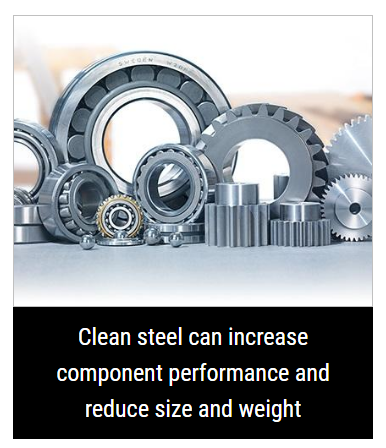Welcome to Sino Bearings web
24x7 HOTLINE:+86-28-81454188

 NEWS
NEWS
Patrik Ölund explains how clean steel offers new design possibilities for longer-lasting, high-performance components
Automotive component designers are on a constant search for materials that are lighter, stronger and capable of handling ever greater and more complex loads. They particularly value high mechanical strength. Yet although this is important, it is actually metal fatigue that accounts for the majority of premature failures in service. To combat this, Ovako has focused on developing clean steels in which the small inclusions that give rise to fatigue failure are closely controlled.
Fatigue failure occurs when a component fails after a number of repeated loadings, even when the peak load is well below the material’s ultimate tensile stress (UTS). The fatigue performance of a material is determined by carrying out laboratory tests, usually in the form of rotating bending fatigue (RBF) testing.
The number of cycles to failure at varying levels of stress is recorded – the statistical nature of fatigue requires a number of tests to be carried out. Eventually, a “safe load” or “fatigue load limit” is established’ at which the sample will survive without failure beyond a certain number of cycles (typically 3–10 million).
Inclusions Influence Fatigue Life
Extensive, long-term investigation of the fatigue performance of steels has identified clearly that defects such as non-metallic inclusions can initiate fatigue failures. This is because inclusions, typically larger sulphides in conventional steels and smaller oxides in cleaner steels, act as localised stress raisers. That means they cause the nominal load on a component to multiply beyond its safe fatigue limit. This results in cracks that propagate under cyclic loading, eventually resulting in failure.
A clean steel that contains smaller sized defects will therefore provide a longer fatigue life than conventional steel.
Fig. 1 illustrates the strong relationship between defect size and fatigue strength. When larger defects are present a lower stress will cause fatigue failure. Conventional steels often have significant amounts of defects from 60 to 80 μm or even larger, with a resulting fatigue strength of around 400 MPa. Yet in a clean steel, where inclusions are limited to less than 20 μm, the fatigue strength increases to over 600 MPa and even higher.
The most important difference between conventional steel and clean steel is the probability of detrimental defects occurring in the area of a component subjected to high load, where fatigue failure could initiate. Using a clean steel decreases this probability significantly. There is also much less scatter in the test results. So, using a clean steel reduces the need to use a high safety factor to take account of the potential variability in performance.
New opportunities
The major design opportunities offered by steel cleanness is important for designers who have in the past relied on old standards. Modern steel production practices have opened up a new level of performance that makes it possible to downsize or even redesign components.
Ovako’s Bearing Quality (BQ)-Steels are high cleanness steels with a reduced defect size. This can help improve design life and/or increase performance. Moderate design changes can also be made while securing high and consistent quality end-user products.
Isotropic Quality (IQ)-Steels are designed to have small and isolated inclusions with a cleanness comparable to re-melted steels. They have isotropic properties that can withstand heavy loads in all directions. This makes IQ-Steel suitable for complex load cases, such as in gears.
Fig.2. shows the results of RBF testing on different types of steel loaded in both the longitudinal and transverse directions. Depending on the loading mode, both BQ-Steel and IQ-Steel offer an improvement over conventional steel.
Testing For Defects
The conventional approach to testing for defects is centred around destructive testing. However, this limits the sample size and cannot truly verify the mechanical performance. Instead, for clean steel Ovako deploys a portfolio of advanced tests using high-frequency ultrasonics, light optical microscopy (LOM), and scanning electron microscopy (SEM) to verify both the size and distribution of inclusions and defects.
Ideal applications
With regard to the ideal applications for these solutions, Ovako is finding that IQ-Steels are already a popular choice for design engineers working in high-pressure automotive applications. Modern diesel engines, with high and cyclic injection pressures, have proven to be an ideal application. Transmission components are another emerging area of strong interest.
Meanwhile, BQ-Steel has been a valuable problem-solver in the bearing industry for decades now. It is optimised for fatigue strength by a strict control of steel cleanness. The same approach to fatigue performance is now being applied in many other applications.
Adding Value With Clean Steel
It is true that clean steel comes at a premium against conventional steel. However, when considering the economics of its use it is important to take a holistic view. Because in many cases, clean steel will increase performance as well as reducing size and weight. Potentially it might even decrease the amount of steel required to manufacture the component. Overall, it is entirely possible for clean steel to provide a cost-efficient solution that adds significant value for critical, highly stressed components.